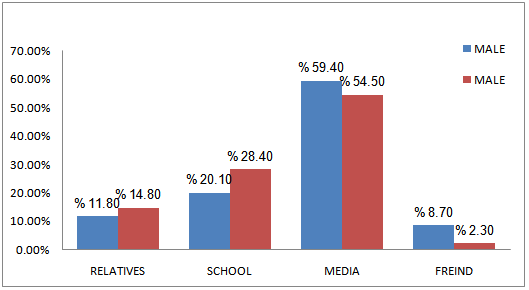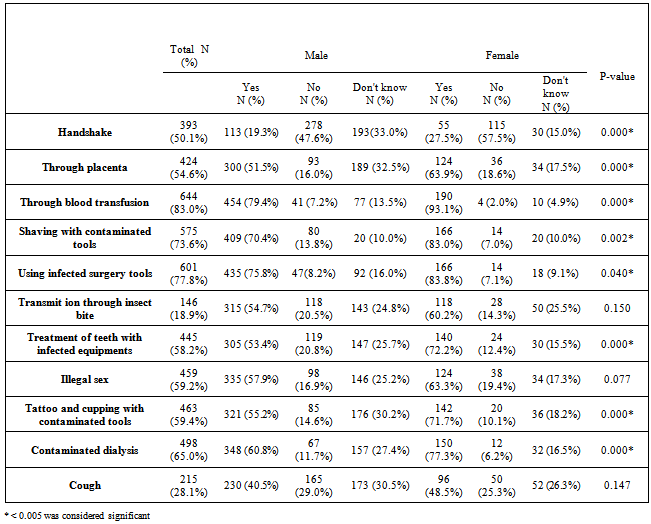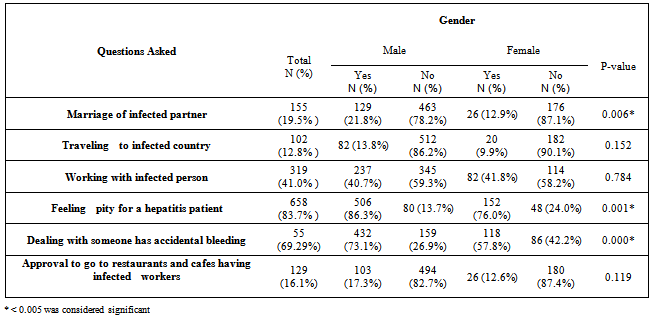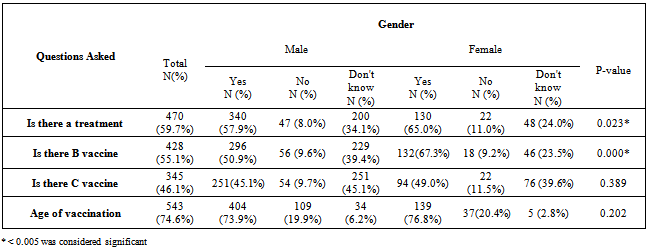-
Paper Information
- Next Paper
- Previous Paper
- Paper Submission
-
Journal Information
- About This Journal
- Editorial Board
- Current Issue
- Archive
- Author Guidelines
- Contact Us
Public Health Research
p-ISSN: 2167-7263 e-ISSN: 2167-7247
2012; 2(5): 167-173
doi: 10.5923/j.phr.20120205.09
Awareness of Viral Hepatitis B and C Infection among First Year Medical Sciences Students in Jazan University
Zaki M. Eisa 1, Saleh A. Eifan 2, Basheer A. Al-Sum 2
1King Fahd Hospital, Jazan, Kingdom of Saudi Arabia
2Botany and Microbiology Deep, College of Science, King Saud University, P.O.Box 2455, Riyadh 11451, Saudi Arabia
Correspondence to: Basheer A. Al-Sum , Botany and Microbiology Deep, College of Science, King Saud University, P.O.Box 2455, Riyadh 11451, Saudi Arabia.
| Email: |  |
Copyright © 2012 Scientific & Academic Publishing. All Rights Reserved.
The purpose of this study is to assess the knowledge level of viral hepatitis B and C among the first year male and female students of medical sciences, at Jazan University, Saudi Arabia during the period from September, 18 to October, 25 of 2010. Data was analyzed by SPSS. 17. by the Pearson's coefficient Chi-Square test and p value < 0.05 was considered significant. A total of 824 students participated with 612 (74.3%) males and 216 (25.7%) females. It was found that more than half of the students (64.4%) had basic awareness about hepatitis B and C infection as well as about symptoms. The knowledge of mode of transmission among our students was a moderate number (57.1%). The mean of the percentage of positive beliefs and attitudes which obtained from our responders was only (40.4%). The students had moderate awareness regarding treatments and vaccinations as prevention and control of infection with Hepatitis B and C (58.9%). The mean knowledge of females and males was comparable, whoever; females depicted higher base knowledge regarding mode of transmission, treatment and vaccination awareness.
Keywords: Hepatitis B and C, Students of Jazan University of Medical Sciences, Saudi Arabia
Cite this paper: Zaki M. Eisa , Saleh A. Eifan , Basheer A. Al-Sum , "Awareness of Viral Hepatitis B and C Infection among First Year Medical Sciences Students in Jazan University", Public Health Research, Vol. 2 No. 5, 2012, pp. 167-173. doi: 10.5923/j.phr.20120205.09.
Article Outline
1. Introduction
- Hepatitis B and C are the major health problems globally casting an enormous burden on health care system and major source of patient’s misery,1[15], 2[21]. Hepatitis B virus (HBV) infection has been recognized as an important occupational hazard for health care workers 3[19]. Studies have shown that one third of the global population is infected with HBV and 350 million people are lifelong carriers 4[11]. Different studies ranked Saudi Arabia among the countries with high prevalence of infection Hepatitis B and C5[1],6[7],7[6]. Elliott, 2005 showed that medical students are high risk group for blood born infections including HBV and HCV, as during the course of clinical work, they are in direct contact with patients, blood, injection and surgical instruments, and the undesirable accidents which happened during the initial period of practical training, and lack of experience and professional skills increases the risk of infection in the course of invasive medical procedures 8[17]. Many surveys were conducted on students and most of these studies shown that students do not have adequate knowledge about hepatitis B and C,9[2],10[3],11[13]. Therefore, it is vital to study the level of information of this group about hepatitis. General knowledge of health staff about viral hepatitis and its transmission and prevention can reduce the spread of this disease in hospitals and in society.The study was conducted to assess the knowledge level and practice of viral hepatitis B and C amongst medical sciences first year students of Jazan University. If level of awareness is insufficient, we should increase alarm to their knowledge about viral hepatitis in the following years of their education. It is crucial also to build their awareness of hepatitis during the foundation year prior the first medical year.
2. Material and Methods
- This descriptive study was conducted in Jazan University, Saudi Arabia, first year medical science males and female students, in separate campuses. For the present study a total of 824 students participated with 612 (74.3%) male and 216 (25.7%) females. A validated well structured Arabic questionnaire designed by infectious diseases, epidemiology and health education specialists comprised of 35 close ended questions concerning basic knowledge of the disease regarding etiology, risk behaviors, mode of transmission, treatment, prevention and beliefs as well as attitudes towards patients with viral hepatitis infection were distributed to students in the class rooms, during the period from September, 18 to October, 25 of 2010.Informed consent was taken. Data were analyzed by Statistical Package for Social Sciences software (SPSS version 17 for Windows). Frequencies of responses were computed, knowledge between male and female students was compared by the Pearson's coefficient Chi-Square test, p value < 0.05 was considered significant.
3. Results
- A total of 824 students participated with 612 (74.3%) male and 216 (25.7%) female. The mean age of the participants in this study was 19.02±.027 (Mean±SD). The maximum and minimum ages were 21 and 17, respectively. The responses were analyzed according to gender status. Almost of the students 687(85.3%), male 491(81.7%) and female 196(96.1%) heard about viral hepatitis with significant difference between female and male are shown in Figure 1.Low number of the students 154(22.2%), male 104 (20.1%) and female 50(28.4%) received their information from school with significant difference (P = 0.004) are shown in Figure 2. Most of the students 591(81.3%), male 419(78.6%) and female 172(88.7%) were aware that virus is a common cause of viral hepatitis with significant difference (P = 0.001) are shown in Figure 3.Majority of the students 687 (90.3%), male 513 (90.6%) and female 174(89.2%) responded that it is a disease of liver are shown in Figure 4. Low number of the students 257(35.4%), male 197 (36.5%) and female 60(32.3%) knew that health workers are the most workers at risk (p=0.049) are shown in Figure 4. Regarding the characteristic symptom of hepatitis 496 (66.2%) of students male 334(60.6%) and female 162( 81.8%) marked jaundice with significant difference (p<0.001). Low number of the students 337(44.3%), male 227 (40.2%) and female 110(56.1%) were aware that the children are the most susceptible age with significant difference (P = 0.001). With respect to the complication of hepatitis 530 (73.3%) of students, male 389(72%) and female 141(77%) chose liver cancer with no significant difference. The responses of questions asked regarding mode of transmission of Hepatitis B and C are given in Table 1, where we noticed most of the students 644(83%), male 454(79.4%) and female 190(93.1%) recognized blood transfusion with significant difference (p<0.001). About 575 (73.6%) students, male 409(70.4%) and female 166(83.7%) knew shaving with contaminated tools with significant difference (p=0.002). Nearly 601 (77.8%) students, male 435(75.8%) and female 166(83.8%) recorded using infected surgery tools with significant difference (p=0.040), moderately high number of the students 498 (65.0%), male 348(60.8%) and female 150(77.3%) marked contaminated dialysis with significant difference (p<0.001). Less students recognized that insect bite and cough are not mode of transmission 146 (18.9%) and 215(28.1%) respectively with no significant difference between male and female. More than half the cohort answered handshake, through placenta, treatment teeth with infected tools, tattoo and cupping with contaminated tools, illegal sex 393 (50.1%), 424(54.6%), 445(58.2%), 459 (59.2%), 463 (59.4%) with (p <0.001,<0.001,< 0.001, <0.001, =0.077) respectively. In Table 2, 470 (59.7%) students, male 340 (57.9%) and female 130 (65.0%) knew that there is treatment with significant difference (p=0.023). Only 428 (55.1%) students, male 296 (50.9%) and female 132 (67.3%) recorded that there is B vaccine with significant difference (p<0.001). Nearly 345(46.1%) students, male 251 (45.1%) and female 94 (49.0%) knew that there. Is C vaccine with no significant difference (p=0.389).543 (74.6%) students, male 404 (73.9%) and female 139 (76.8%) with no significant difference (p=0.202). Concerning to beliefs and attitudes towards the disease. We noticed 658 (83.7%) students, male 506 (86.3%) and female 152 (76.0%) had feeling pity for a hepatitis patient with significant difference (p=.001). However, Only 155 students (19.5%), male 129(21.8%) and female 26(12.9%) agreed to marry of a viral hepatitis infected partner with significant difference (p=0.006). A total of 550 (69.2%) students, male 432 (73.1%) and female 118 (57.8%) accepted to deal with someone has accidental bleeding with significant difference (p<0.001). While, 102 (12.8%) students, male 82 (13.8%) and female 20 (9.9%) knew that Traveling to infected country with no significant difference (p=0.152). Viral hepatitis infected person or colleague in the same place was accepted by 319(41%) students, male 237(40.7%) and female 82(41.8%) with no significant difference (p=0.784). One hundred twenty nine (16.1%) students, male 103 (17.3%) and female 26 (12.6%) approved to go to restaurants and cafes having infected workers with no significant difference (p=0.119). Males achieved higher attitudes and practices than female.
 | Figure 1. Do you Hear About Viral Hepatitis |
 | Figure 2. Source of information |
 | Figure 3. What Is The Organ That Will Be Infected |
|
|
 | Figure 4. What Is The Workers Field at Risk |
|
4. Discussion
- Hepatitis B and C virus infection can evoke fears in health care providers, including medical students and the general public12[10],13[20]. In general, health care professionals and the general public have been reported to have negative attitudes towards people with HBV infection and usually nursing and first year medical students show great fear of contagion, negative emotions and professional resistance14 [9],15[12]. This study was confined to evaluate knowledge of medical sciences first year students in Jazan University. It aims to discover the deficits in the health education programs and relate the knowledge to the improvement in the prevention programs against hepatitis B and C infection in students that represent a dynamic, highly educated and highly positioned group in the society. Therefore, they are expected to play a crucial role in limiting the increasing number of HBV infection cases and in promoting health education. The findings of this work had some disappointing facts on basic knowledge, as 11.3% of students did not hear about viral hepatitis. Nearly, 10% did not recognize the specific organ of the disease. Only 75% received their knowledge not from school, which, suppose to be the formal source of information, but,16[16], found that the students' information source were teacher, books, media, friends, internet and relatives respectively. Although 26% of the participants either think that Hepatitis B and C infection is not caused by a virus. While, 28 % were not aware with the symptoms of the disease. Similar studies revealed that students in developed countries have a lot of misconception of these infectious diseases17[18],12[10]. Our study showed that 51 % did not know the workers at risk. Also, 25% had no idea about the complication of Hepatitis B and C. Another study about the knowledge of students regarding viral hepatitis infections reported that the highest level of awareness was found about viral Hepatitis infection and the lowest level of knowledge was found about the symptoms and treatment of different types of hepatitis. No significant difference was found in the level of awareness between male and female medical students18[4]. The previous studies was in contrast to our study, where we recorded mean of percentages of asked questions was more than half the students (64.4%), that had base awareness about hepatitis B and C infection as well as about symptoms. The differences between current study and the previous studies could nature of societies. Although mean awareness were comparable in male and female, female students awareness were found significantly higher than males. These findings imply giving more attention to male students when designing educational programs. Concerning the modes of HBV transmission, most of participants were not sure that coughing could transmit the disease or not (72%). In spite of, the majority of participants indicated poor knowledge about the role of insect bite in transmission (81%). Some of students attained knowledge of how it can be transmitted and how it can be avoided. Majority of students regarded blood transfusion, syringes, needles, surgical instruments, sharing of razors as important source of transmission of infection. Almost similar results were found in previous literatures 9[2],10[3]. Females achieved more knowledge than male with significant differences that were noticed for these modes of transmission: not by handshake (p<0.001), placenta (p<0.001), blood transfusion (p<0.001) razor (p<0.005), surgery (p<0.05), teeth surgery (p<0.001), tattoo and cupping (p<0.001), and dialysis (p<0.001). Generally, the mean knowledge of mode of transmission among our students was a moderate number (57.1%). Several other surveys conducted in different parts of the world regarding hepatitis B and C showed poor knowledge regarding these diseases19[5],20[14]. The mean of the percentage of positive beliefs and attitudes which obtained from our responders was only (40.4%), some, misconceptions were observed, in the present study, regarding interaction with infected individuals especially marriage of a viral Hepatitis infected partner, travelling to infected country and approval to go to restaurants having infected workers. In spite of the responders feeling pity for infected person, moderate number of the students expressed fears regarding living or working with infected individuals. Similar negative attitudes toward people with viral Hepatitis infection have been recorded by 14[9].We noticed that females had higher negative attitude than males in marriage (p=0.006), feeling pity (p=0.001) and dealing with bleeding (p<0.001). Thus these misconceptions regarding the attitudes, reflects a false perception of the disease among those educated students. Moreover the students achieved moderate awareness regarding treatments and vaccination as prevention and control the infection with Hepatitis B and C (58.9%).
5. Conclusions and Recommendation
- In conclusion on the basis of the lower level of awareness regarding viral Hepatitis B and C type infections in first year medical students, It is suggested that a comprehensive training program for the awareness of HBV and HCV infections in society should be initiated. Specially well-structured health education programs should be adopted at school level to address different misconceptions with the involvement of parents. The lack of awareness depicted a need for targeted educational intervention aimed at reducing HBV infection and HBV related liver cancer mortality. It is also recommended that the similar survey should be carried out among final year medical students to assess and evaluate their knowledge about HBV and HCV infections
ACKNOWLEDGEMENTS
- This project was supported by King Saud University, Deanship of Scientific Research, College of Science Research Center.
 Abstract
Abstract Reference
Reference Full-Text PDF
Full-Text PDF Full-Text HTML
Full-Text HTML

